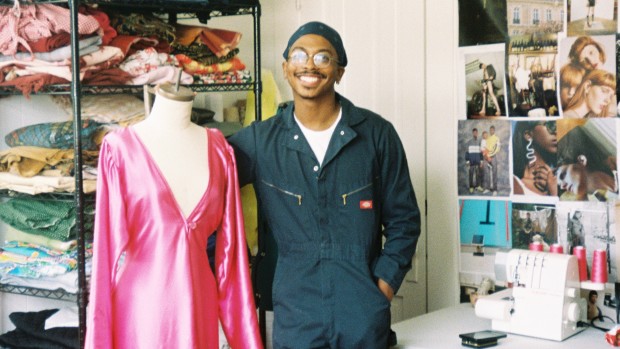Shortly after Brandon Hayden turned 21, he bought himself a sewing machine. Not just any sewing machine, mind you, but the iconic Singer Heavy Duty 4452.
A true workhorse, the 4452 has a decades-long reputation for being as beginner-friendly as it is versatile, capable of a wide range of sewing projects, from quilting to garment construction.
It was a perfect match. Indeed, Hayden was a beginner, but he was also ambitious, with lofty plans for what his 4452 could do for him in the future. He had been thrifting a bulk of his wardrobe since high school, after all, and in the years since, grew more and more frustrated that the gems he scored via consignment weren’t fitting the way they could if he could just tailor them himself. (“Thrift-flipping,” he calls it.)
So, in December 2017, armed with his sparkly-new Singer sewing machine and a stream of Youtube tutorials, Hayden set off on his first sewing project: a single pillowcase. (“I used that pillowcase for years.”) After that came a Carhartt jacket that he transformed into a crossbody bag — an endeavor so grueling, it prompted a self-imposed sewing hiatus.
“I had never done any sewing before, and suddenly, I was working with heavy denim,” Hayden, who is based in Atlanta, remembers. “I didn’t know what I was doing. Needless to say, though, it got finished.”
Five years later, Hayden has held onto the Carhartt-jacket-bag as a sort of trophy — a symbol of the effort and the desire to be better, to learn more, to do new things. That’s what sewing is all about, he says.
This a pivotal message throughout Hayden’s growing TikTok community under the handle @happilydressed, where his more than 20,000 followers (and counting) turn to him as an accessible, inclusive sewing resource for beginners. More than 75,000 people have watched him sew his first button-up shirt; 208,000 have tuned in to see him make a hoodie from scratch out of a $5 blanket he plucked from the depths of Goodwill.
Hayden’s platform, though impactful, isn’t alone. According to TikTok data provided to Fashionista, the hashtag for #sewing has reached 20.5 billion — yes, billion — global views, a 90% increase from 9.7 billion just a year prior. And TikTok finds that men, specifically, are helping to drive this shift: #boyswhosew had 53.4 million global views, up from 51.5 million (or 2,220%) in the past 12 months. It’s a trend Hayden, for one, endorses wholeheartedly.
“It’s really empowering to see men getting out of this tight and constricting narrative of what men should like and men should enjoy,” he says, “and to instead listen to what makes themselves feel seen in a world where there are so many people.”
View the original article to see embedded media.
Women, in particular, have latched onto this credence for centuries, if not millennia. Researchers have found that humans developed eyed sewing needles in what’s now Siberia and China as long as 45,000 years ago. But the intention — and the output — changed in 1853, when inventor Joseph Singer improved upon existing sewing machines and released the first marketable one. For women who made clothes for themselves and their families, sewing machines like Singer’s gave them the gift of time, liberating them from hours of strenuous hand-sewing. By the 1860s, women on either side of the Mason-Dixon line began forming sewing societies, making quilts and clothing for their soldiers and, of course, for themselves.
A familiar, gender-based division of labor, by which men specialize in market work and women in domestic work, followed, even among recreationalists. In the tailoring trade, for example, “male tailors used their wives to make button holes, turn cuffs and fell seams — tasks that continued to be considered women’s work throughout the nineteenth century,” late author and women’s historian Joan Perkin wrote in a 2002 edition of History Today.
Close to two centuries later, this reputation has been hard to shake, particularly among a certain hypermasculine mindset. The numbers don’t lie: A 2006 Home Sewing Association (HSA) survey found that 35 million American women considered themselves to be sewers. (The HSA disbanded in 2007, and population data has been sparse ever since.) Weigh that against the stat that only one in five men can sew on a button, as revealed by a 2008 report out of U.K. arts-and-crafts superstore Hobbycraft.
On TikTok, #boyswhosew creators are chipping away at this binary bit by bit.
“When I first started, I was kind of nervous, because there aren’t a lot of boys I knew who sewed,” says Kai McPhee, known as @knawtkai on the platform. “Even family members would say, ‘Oh, you sew?’ And they would be impressed, just because I’m a man. But men are missing out on so much because we’re not sewing. I want to spark that creativity.”
Like Hayden, McPhee took up sewing out of a love of fashion. As part of the curriculum of his art-focused high school in Baltimore, McPhee enrolled in a sewing class in which he constructed one (1) sock, and that was all it took: “I really liked that I was able to make something,” he says. “I wanted to continue that.”
At the onset of the pandemic, McPhee took his talents to TikTok, where he’s since grown a following of more than 368,000, allowing him to relocate to New York City and branch out as a creator full-time, all while pursuing a career in fashion. (He cites Rick Owens, who began his own career studying pattern-making, as an inspiration.) McPhee’s how-to-based Sewing 101 videos have proven especially popular: Since launching the series in March, the clips — which range from how to do zig-zag stitch to, crucially, how to sew a button — have accrued a cumulative 1.8 million global views.
His DMs are their own resource altogether.
“That’s why I connect so well with my audience, because I was once that little kid at home who didn’t know anything about fashion or even didn’t know how to sew,” says McPhee. “I try to answer most of my DMs so they can get as much insight as possible.”
View the original article to see embedded media.
Both Hayden and McPhee have significant followings on other platforms. But TikTok, they say, offers something different, with bite-sized educational content that’s not as commitment-heavy as something like YouTube. Hayden saw it right away, when the app’s omniscient algorithm started hitting the gas on a video in which he shared his own jacket pattern, now available to his followers for free.
“As a Zillennial, I’m right in the middle,” says Hayden. “I’m not cool enough to be Gen Z and blow up on TikTok, and I’m just old enough to be a little lame. It took a while to find my footing, so it wasn’t until recently that I started to give a real effort again and gear more toward educational content.”
Hayden is taking his educational offerings offline, too: He’s set to launch an in-person community space, in which interested folks of all gender identities can visit a physical space and use its range of domestic and industrial sewing machines, just as one would a gym. The goal, he says, is to provide his community with the same opportunities to build the tools that equip their life in whatever way they want to.
“Sewing reminds you of your agency,” says Hayden. “You have two hands, you have a brain, you’re able to put things together. You can mend and repair and create. It’s so cool to see what these individuals now get to do without the facade that something’s not for them just because they’re male.”



